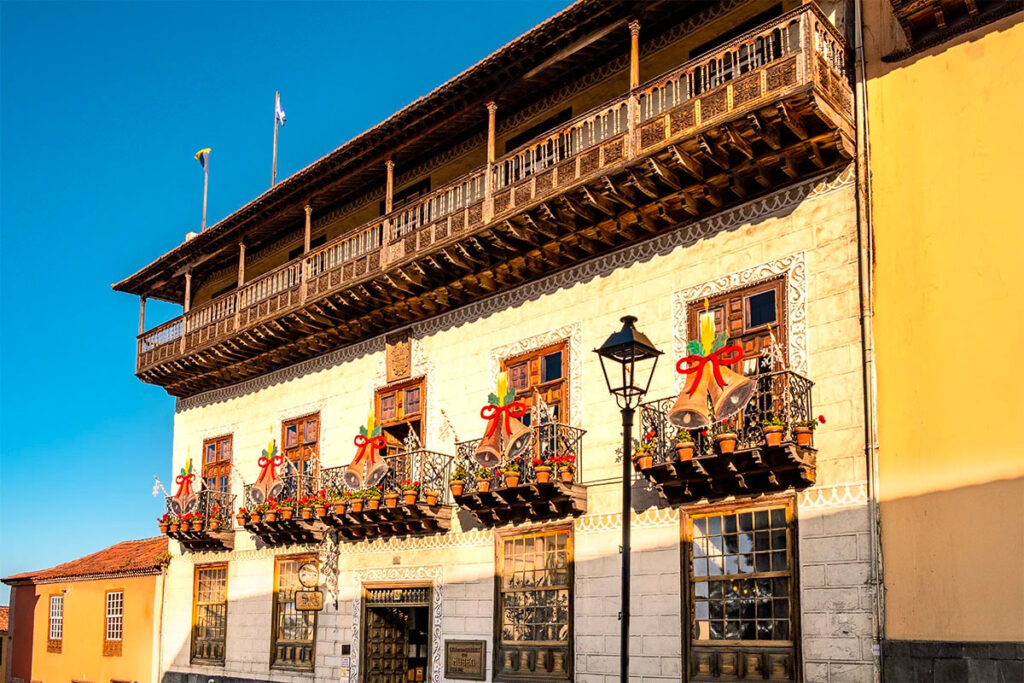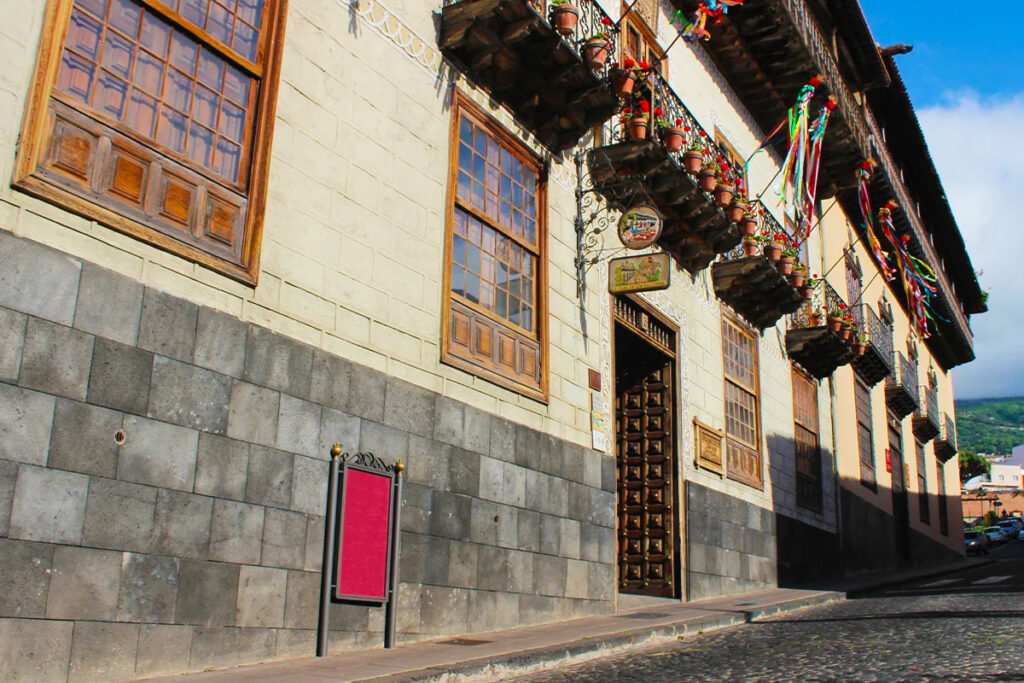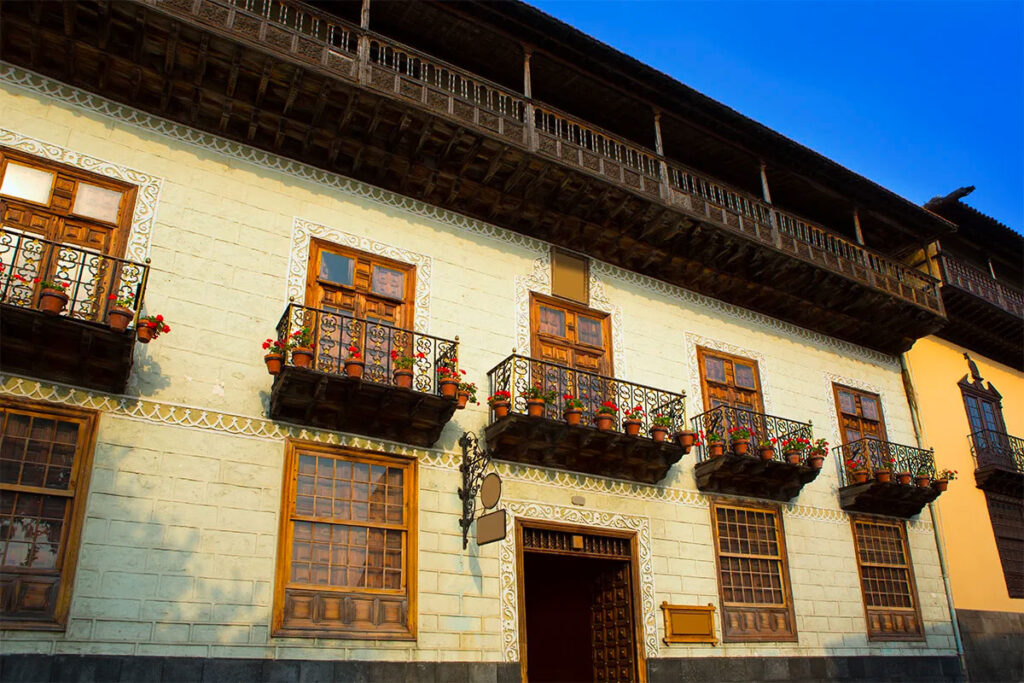Have you ever dreamt of stepping back in time to explore the rich cultural heritage of the Canary Islands? Casa de los Balcones, a 17th-century gem in the charming town of La Orotava, Tenerife, offers a fascinating journey into the past and a chance to immerse yourself in traditional Canarian life.
- Explore the incredible Casa de los Balcones, an astonishing historical treasure showcasing traditional Canarian architecture!
- Step inside for a journey back in time to experience Canarian culture and history with guided tours & audio guides.
- Discover La Orotava’s must-see attractions and explore Tenerife’s stunning natural beauty, an abundance of unforgettable experiences await!
Exploring the Casa de los Balcones: A Historical Treasure
Nestled in the heart of La Orotava’s historic center, the Casa de los Balcones is a remarkable example of traditional Canarian architecture. Built in 1632, this 17th-century manor house-turned-museum showcases the lifestyle of the wealthy Valencian family of Domingo Sancho Simón-Pont and his wife María Enriqueta Torrelles. Its stunning wooden balconies and intricate craftsmanship serve as a testament to the island’s rich history and artistic traditions.
Walking through the cobbled streets of Calle San Francisco, the stately wooden balconies and elegant façade of Casa de los Balcones catch your eye. These iconic balconies, made from Canarian pine wood, are a symbol of the island’s connection to transoceanic voyages, as the Canary Islands were a crucial port of call for ships traveling between the Iberian Peninsula and the Americas.
The Wooden Balconies
The beautiful wooden balconies are a distinct architectural feature of Canarian manor houses. They reflect the influence of Plateresque design, a style characterized by ornate decorations and intricate carvings. The balconies at Casa de los Balcones were crafted from locally-sourced tea wood, a material known for its durability and resistance to harsh weather conditions.

Admiring these striking balconies, it’s hard not to think of the island’s importance in transoceanic voyages. After all, the Canary Islands were a key stopover for ships sailing between Europe and the Americas. The craftsmanship of these balconies represents the cultural exchange that occurred during this period, and the influence of Canarian architecture on other styles throughout the region.
Calle San Francisco: The Heart of La Orotava’s Historic Centre
Historic buildings from the 16th century line Calle San Francisco, a quaint street in La Orotava. Along this charming street, you’ll find the San Francisco church, built in 1671 on the site of the old San Roque church, as well as other notable landmarks such as Casa Eladia Machado and Casa Lercaro.

A visit to Calle San Francisco takes you beyond a walk down memory lane, immersing you in La Orotava’s rich history and culture. As you wander through this enchanting street, you’ll be captivated by:
- The magnificent architecture
- The vibrant local life
- The many traditional festivals and events that take place here, such as Baile Piñata San Juan, Holy Week, and the Corpus Christi Festival.
Inside the Casa: A Glimpse of Canarian Life
Stepping inside Casa de los Balcones feels like a journey back in time, offering a glimpse of traditional Canarian life. The central courtyard, a key architectural feature, provides a delightful escape from the island’s high temperatures, while also improving ventilation. The wooden panels adorned with flower motifs exemplify the island’s traditional carpentry skills and the timeless beauty of Canarian craftsmanship.
Spaces dedicated to showcasing the island’s rich heritage can be found on both the ground and first floors. Whether it’s:
- exploring the workshops where local artisans create stunning crafts
- browsing the unique souvenirs in the gift shop
- admiring the antique furniture and living quarters of the Canarian gentry in the house museum
Your visit to Casa de los Balcones promises to be a memorable journey into the past, offering a fairly modest experience.
Ground Floor: Workshops and Gift Shop
As you venture through the ground floor of Casa de los Balcones, you’ll be greeted by workshops where skilled artisans create traditional Canarian crafts such as:
- Pottery
- Woodcarving
- Weaving
- Embroidery
These workshops not only showcase the island’s rich cultural heritage but also provide an opportunity to witness the incredible talent and dedication of local craftsmen and women.
The gift shop at Casa de los Balcones is a treasure trove of unique souvenirs and locally made products, far from the typical tourist tat. From miniature balconies of La Orotava to traditional Canary timple guitars, you’ll find a wide variety of one-of-a-kind items to remind you of your visit to this fascinating house museum.
First Floor: House Museum and Living Rooms
Ascending the spiral staircase, fashioned from a single piece of pine wood, brings you to the first floor of Casa de los Balcones. Here, you’ll find the house museum, which offers a glimpse into the lifestyle of the Canarian gentry and the island’s rich history. The museum features exhibits of former residential rooms, including:
- the living quarters
- the kitchen
- the bathroom
- the dining room
There is also a stunning collection of antique furniture on display.
The House Museum represents the period of Canarian history that is associated with the colonization of the Canary Islands in the 15th century. As you explore the beautifully preserved living rooms and immerse yourself in the island’s past, you’ll gain a deeper understanding and appreciation for Tenerife’s rich heritage and the unique culture that has been preserved through the centuries.
Visiting Information: Plan Your Trip to Casa de los Balcones
Planning ahead and gathering key information on parking, accessibility, entrance tickets, and guided tour options ensures you make the most of your visit to Casa de los Balcones. The museum is open Monday to Sunday from 8:30 AM to 7:00 PM, providing ample time to explore the house and its surroundings at your leisure.

Bear in mind the variety of discounts for residents, students, and people with reduced mobility during your planning process, not forgetting the option to add a glass of wine to your museum experience. For families with children under 12, the good news is that they can enter for free, with no entrance fee!
Parking and Accessibility
Visitors can find a free car park opposite Casa de los Balcones, with a few parking spaces located nearby. The ground floor and the interior patio of the museum proper are wheelchair accessible, but the second floor is not accessible for wheelchair users. Additionally, the area offers other parking spaces for visitors’ convenience.
Public transport options are also available, with bus lines 381 and 382 stopping near the museum.
Entrance Tickets and Guided Tours
Entrance tickets to Casa de los Balcones are priced at just $3.24, with reductions available for students, seniors, and groups. For a truly immersive experience, consider opting for a guided tour, which covers German, English, Italian, French, and Spanish languages. Audio guide services are also available, providing an informative and engaging way to explore the museum at your own pace.
For those looking to make their visit even more memorable, combined tickets are available that include both a tour of the house and a delicious lunch with a choice of two set menus: the Teide or the Chinyero. Both menus offer a delightful taste of Canarian cuisine, perfect for refueling after exploring the wonders of Casa de los Balcones.
Preserving the Past: The Importance of Casa de los Balcones
The preservation of the past is crucial in maintaining a connection with our history and ensuring future generations can appreciate and learn from the rich heritage of Tenerife. Casa de los Balcones serves as an ethnographic museum that showcases traditional crafts from the Canary Islands, providing a platform for visitors to appreciate and learn about the beauty and significance of Canarian embroidery and other local crafts.
Preserving historic sites like Casa de los Balcones allows us to:
- Honour the architectural, cultural, and artistic heritage of the region
- Create a legacy that enriches the lives of locals and visitors, ensuring these treasures endure
- Recognize the contributions of the Méndez-Fonseca family, who once resided in the house and made significant contributions to the promotion and protection of the Canary Islands’ traditional crafts, arts, and cultural practices
- Preserve this unique cultural landmark for future generations
Canarian Embroidery and Local Crafts
Canarian embroidery, renowned for its delicacy and intricate details, is a symbol of the island’s rich history and cultural traditions. Artisans use vibrant colored threads to create breathtaking designs, which adorn:
- traditional costumes
- tablecloths
- church ornaments
- and more
Canarian women traditionally sew, embroider, and weave the costumes, showcasing the skills and dedication passed down through generations.
Casa de los Balcones is not only a stunning example of traditional Canarian architecture but also a showcase for the island’s vibrant arts and crafts. As you explore the museum, you’ll encounter various exhibits and workshops dedicated to preserving and promoting these unique art forms. Some of the crafts you can expect to see at Casa de los Balcones include:
- Intricate embroidery
- Delicate pottery
- Handwoven textiles
- Woodcarving
- Basket weaving
The Casa de los Balcones is a treasure trove of Canarian culture, ensuring the preservation of these traditional crafts for future generations.
The Méndez-Fonseca Family Legacy
The Méndez-Fonseca family, owners of Casa de los Balcones, played a crucial role in preserving Canarian heritage. Through their generous support and patronage, they helped preserve the unique cultural heritage of the Canary Islands for future generations. Their legacy in Casa de los Balcones is the incredible preservation of traditional Canarian architecture and the showcasing of Canarian history and culture.
By investing in the renovation and maintenance of this historic manor house, the Méndez-Fonseca family ensured that it remains a significant cultural landmark in Tenerife. Their commitment to protecting the island’s rich heritage serves as an inspiration for others to follow in their footsteps, safeguarding the past for generations to come.
Beyond the Casa: Exploring La Orotava and Tenerife
Casa de los Balcones is certainly an unmissable attraction in La Orotava, but the town and the island of Tenerife abound with other delights. From historic sites and museums to beautiful beaches and volcanic landscapes, there’s no shortage of adventures to be had beyond the stunning manor house.

Whether you’re exploring the quaint streets of La Orotava, sampling traditional Canarian cuisine in a local guachinche, or venturing into the island’s lush forests and unique wildlife, Tenerife is a destination that offers an abundance of unforgettable experiences.
Must-See Attractions in La Orotava
La Orotava, extending beyond Casa de los Balcones, is replete with must-see attractions. Some of the highlights include:
- Marveling at the beautifully landscaped Jardines Victoria
- Visiting the informative Centro de visitantes Telesforo Bravo
- Indulging in some retail therapy at La Villa Centro Comercial
- Stopping by the picturesque Ajuntamiento Plaza
- Exploring the historic La Rosa de Piedra
- Admiring the stunning L’église et l’ancien Couvent de San Agustín
Wandering through the streets of La Orotava offers the perfect opportunity to sample the town’s traditional Canarian cuisine. Restaurants such as Guachinche La Cernidora and Restaurante Aguamansa La Orotava offer a tantalizing taste of the island’s rich culinary heritage, providing an unforgettable dining experience.
Exploring the Natural Beauty of Tenerife
Tenerife’s natural beauty is truly awe-inspiring, including:
- Stunning beaches
- Volcanic landscapes
- Lush forests
- Unique wildlife, such as the Tenerife lizard, Tenerife blue finch, and the long-eared bat
- Various species of birds and marine life, such as the great blue whale and orca
To fully experience the natural wonders of Tenerife, visit some of the island’s best beaches, such as:
- Playa de las Teresitas
- Playa del Duque
- Playa de las Vistas
- Playa El Medano
- Playa El Bollullo
The best time of year for outdoor activities in Tenerife is during the spring and fall months, offering cooler temperatures and more comfortable weather for hiking, paragliding, and exploring the island’s breathtaking landscapes.
Summary
Casa de los Balcones is a captivating portal into the past, offering a unique insight into the rich heritage of the Canary Islands. From its stunning wooden balconies and charming Calle San Francisco location to the traditional crafts and fascinating history that lie within its walls, Casa de los Balcones is an unforgettable experience. Venture beyond the Casa to explore the charming town of La Orotava and the natural beauty of Tenerife, and you’ll find yourself immersed in a world of history, culture, and breathtaking landscapes that will leave you yearning for more.
Frequently Asked Questions
What is the history of Casa de los balcones?
Experience the history of Casa de Los Balcones, a celebrated house and museum in La Orotava, Tenerife! Built-in 1632, it boasts stunning canarian artworks, embroideries and artwork installed in living rooms, making it one of the most famous spots in the Canary Islands.
When is the best time to visit Casa de los Balcones?
Visit Casa de los Balcones any day of the week for an exciting exploration of Spanish culture! With extended opening hours from 8:30 AM to 7:00 PM, there’s plenty of time to see it all.
Are guided tours available at Casa de los Balcones?
Yes, Casa de los Balcones offers guided tours in multiple languages, including English, Spanish, German, French, and Italian!
How much does it cost to visit Casa de los Balcones?
Discover Casa de los Balcones for only $3.24! Discounts are available for students, seniors and groups, so start planning your visit today!
Is Casa de los Balcones wheelchair accessible?
Yes, Casa de los Balcones is wheelchair accessible – the ground floor and interior patio are easily accessible for those in wheelchairs. However, the second floor unfortunately cannot be accessed with a wheelchair.
Practical info
It’s best to buy tickets to Casa de los Balcones in advance. You will then avoid standing in a long queue and avoid the risk that all tickets have been sold out, which happens very often in the case of this monument.
- Opening hours: Monday to Sunday 8.30 AM to 6.30 PM.
- Address: C. San Francisco, 3, 38300 La Orotava, Santa Cruz de Tenerife, Spain
- Buy Tickets on GetYourGuide
Casa de los Balcones on a map
Discover Canary Islands
There are seven main islands in the Canary Islands archipelago. Discover all of them and check out the places worth to see.| Island | Tourist attractions and interesting places |
| Tenerife | Loro Park, Jungle Park, Siam Park, Lago Martianez, Monkey Park and other Amusement parks in Tenerife. Teide National Park, volcano Teide (Pico del Teide), Los Gigantes Cliffs, Masca, Anaga Mountains, Pyramids in Güímar, Casa de los Balcones, Cueva del Viento, Dragon Tree. Popular cities in Tenerife: Santa Cruz de Tenerife, Buenavista del Norte, Garachico, Puerto de la Cruz, Puerto de Santiago, Costa Adeje, Taganana, Guía de Isora, San Cristóbal de La Laguna, El Médano, La Orotava, Icod de los Vinos, Arona, San Miguel de Abona, La Matanza de Acentejo, La Victoria de Acentejo, Santa Úrsula, Los Cristianos, Playa de las Américas, Los Realejos, San Andrés, Los Gigantes |
| Fuerteventura | Dunas de Corralejo, Oasis Park, Acua Water Park, Lobos Island (Isla de Lobos), Parque Natural de Corralejo, Ecomuseo La Alcogida. Popular cities, towns, and villages: Puerto del Rosario, Corralejo, Tarajalejo, El Cotillo, Majanicho, La Oliva, Morro Jable, Costa Calma, Caleta de fuste. Popular beaches in Fuerteventura: El Castillo, Playa de Esquinzo |
| Gran Canaria | Tourist attractions: Poema del Mar, El Faro de Maspalomas, Cenobio de Valerón, Pueblo Canario, Necrópolis de Arteara, Casa de Colón. Amusement Parks: Holiday World Maspalomas, Aqualand Maspalomas, Sioux City Park, Palmitos Park, Mundo Aborigen, Camel Safari Park. Natural attractions: Jardín Canario (botanical garden), Pico de Bandama Hill, Barranco de Guiniguada, Pinar de Tamadaba (natural park), Dunas de Maspalomas, Roque nublo, Barranco de Santa Brígida, Cañon del Águila, Doramas Park (Parque Doramas), Parque de Santa Catalina. Popular cities: Las Palmas de Gran Canaria, Maspalomas, San Bartolomé de Tirajana, Playa del Inglés, Puerto de Mogán, Artenara. Beaches in Gran Canaria: Playa de Las Canteras (Plaża Las Canteras), Playa del Inglés, Playa de San Agustín, Playa de Taurito, Playa de Puerto Rico, Playa de Guayedra, Playa del Juncal, Playa Hoya del Pozo, Playa de Melenara |
| Lanzarote | Cueva de los Verdes (cave), Jameos del Agua (cave), Jardín de Cactus (cactus garden), Timanfaya National Park (Montañas del Fuego), Aqualava Water Park, Museo Atlántico Lanzarote (underwater museum), Castillo de San Gabriel (castle), Castillo de San José (contemporary art museum), Papagayo Beach (Playa de Papagayo), Fundación César Manrique (museum and an old house of César Manrique), Los Hervideros, Mirador del río, Volcano El Cuervo, La Geria. Popular cities: Arrecife, Puerto del Carmen, Playa Blanca, El Golfo i Charco de Los Clicos |
| La Palma | Popular cities: Santa Cruz de la Palma, Breña baja, Breña alta |
| La Gomera | Garajonay National Park, Los Órganos, Casa de Colón. Popular cities: San Sebastián de la Gomera, Chipude, Agulo, Playa de Santiago |
| El Hierro | Popular cities: Valverde, La Frontera |



